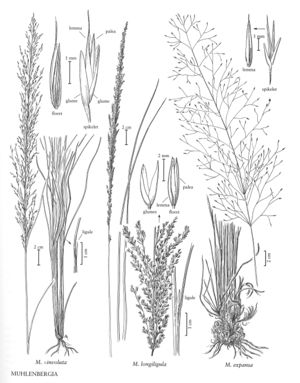Muhlenbergia expansa
Plants perennial; cespitose, not rhizomatous. Culms 60-100 (150) cm, erect from the base, not conspicuously branched; internodes mostly glabrous, sometimes puberulent below the nodes. Sheaths glabrous or puberulent, rounded basally, becoming fibrous, not flat or spirally coiled, at maturity; ligules 1.8-5(10) mm, membranous, firm, strongly decurrent, obtuse; blades 20-50(80) cm long, 2-4 mm wide, flat or involute, smooth abaxially, scabrous adaxially. Panicles 15-50(60) cm long, 5-30 cm wide, longer than wide, diffuse; primary branches 2-20 cm, capillary, spreading 30-100° from the rachises, naked basally, lower branches with 5-20 spikelets; pedicels 4-50 mm, longer than the spikelets, capillary, flexible, widely divergent at maturity. Spikelets 3-5 mm, often purplish, sometimes brownish or bronze. Glumes subequal, 1.5-3.3 mm, shorter than the florets, glabrous; lower glumes 1-veined, unawned; upper glumes usually 1-veined, rarely 3-veined, acute to acuminate, often erose, sometimes mucronate; lemmas 3-5 mm, lanceolate, calluses shortly pubescent, apices acuminate, without setaceous teeth, usually unawned, if, as rarely, awned, awns 1-3 mm, clearly demarcated from the lemma bodies; paleas 2-4.5 mm, lanceolate, acuminate, unawned; anthers 1.5-2 mm, purple. Caryopses 2-2.5 mm, narrowly elliptic, brownish. 2n = unknown.
Distribution
Va., Ga., Tex., La., Ala., N.C., S.C., Miss., Ky., Fla.
Discussion
Muhlenbergia expansa grows in perennially moist to wet soils in pitcher plant bogs, pine savannahs, and flat-woods, usually in sandy soils and at elevations of 0-300 m. Its primary range is the coastal plain of the south-eastern United States.
Selected References
None.
